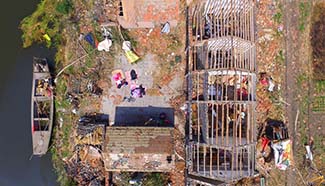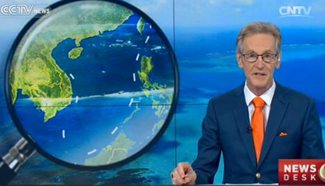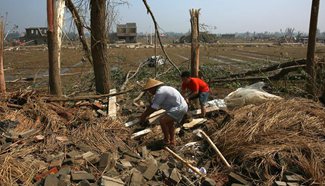PANAMA CITY, June 26 (Xinhua) -- The need to expand the Panama Canal's capacity was acknowledged in a document signed by all the Panamanian political parties on Dec. 31, 1999, the day when the waterway's administration was formally transferred from U.S. hands to Panamanian ones.
In accordance with the 1977 Torrijos-Carter Treaty, this day marked the end of U.S. military presence in bases on the banks of the Canal, the route which the U.S had finished building after the French had failed at the project.
The Miraflores Pact, endorsed by the movements at the time warned, according to an outline from the Panama Canal Authority (ACP), that a navigation shortcut between the "Atlantic and the Pacific" would need important enlargements in the immediate future in order to make it suitable for the demands of world trade.
It was even mentioned in the agreement that building a third set of locks for larger vessels may be needed. At the same time, it was acknowledged that this investment would involve an extremely high cost and extensive national consultation, incorporating the best talents in the country.
The then Panamanian government led by Martin Torrijos (2004-2009) presented a proposal to expand the Panama Canal through a third set of locks on April 24, 2006. The proposal was confirmed with a referendum held in Panama on October 22, 2006.
Another key moment in the Canal's history, in terms of allowing larger vessels to travel through the Panama Canal, was awarding the contract for the project's financial advisory to Mizuho Corporate Bank, Ltd. on Feb. 7, 2007.
Contracts were also awarded in order to prepare an environmental impact study for international legal counseling services in terms of construction contracts, and for supplying international legal counseling services in terms of finance, in February, March and April, 2007, respectively.
On Sept. 3, 2007, blasting formally began in Cerro Paraiso, in the Pacific, commencing the expansion work on the Panama Canal.
On July 15, 2009, Grupo Unidos por el Canal (GUPC) were awarded the contract for designing and building the Canal's new set of locks, and it was the project's most important contract.
Other important steps include contracting Jan de Nul and Dredging International N.V. to respectively dredge approximately 14.8 million cubic meters at the entrance to the Atlantic Ocean and approximately 4.6 million cubic meters of material from Gatun Lake. The agreements were signed on Sept. 28, 2009, and June 7, 2010, respectively.
July 1 of 2011 was when the permanent concrete began to be poured for the third set of locks and, between April and June 2013, the entrances were widened and deepened to allow New Panamax to pass through the widened Canal's new locks.
On April 28, 2015, the last of the 16 gates for the new locks were installed and in June of the same year the project entered into its final stretch when the new locks in Cocoli, in the Pacific, and Agua Clara, in the Atlantic, started to be filled. At that time, the first tests were carried out on the gates.
Another key step was on Sept. 14, 2015, when the fourth phase of the new Pacific Access Channel began to be filled. It connects the Culebra Cut artificial valley with the new locks in the Pacific sector. The new expanded Pacific Access Channel reached Gatun Lake's level on Nov. 2, 2015. On Dec. 24, 2015, clearing the north part of the extended Canal got underway and on Feb. 5, 2016, water reuse tests were carried out.
According to the ACP, a total of 36,740 Panamanian workers and 3,873 foreign workers participated in the expansion project. And out of the foreign workers, the largest majority of Latin American workers were from Colombia and Venezuela.










